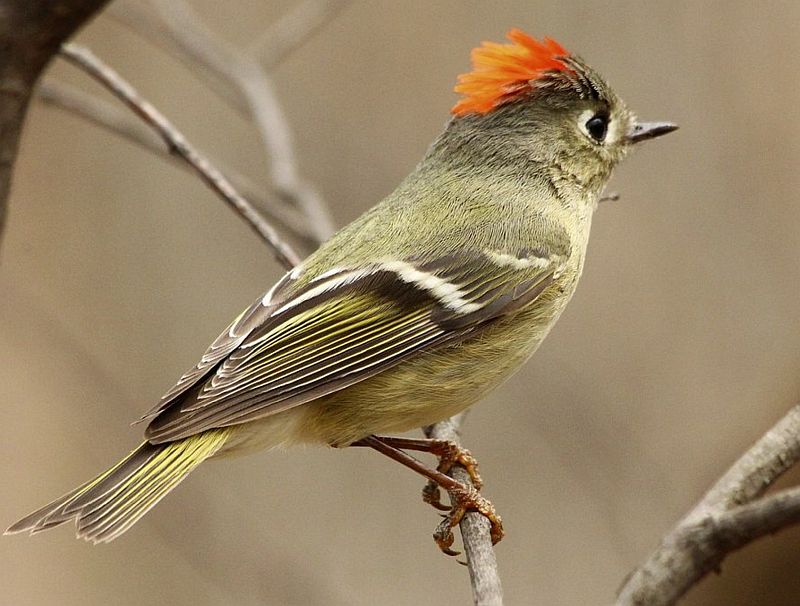Identification: The Ruby-crowned Kinglet (Corthylio calendula) is a transatlantic vagrant. This tiny jewel forages almost feverishly over the lowest branches of trees and shrubs; the consistent flapping of its wings serves as a crucial identifying feature. It differs from Goldcrest in being darker greyish-olive on the head and upperparts and rather warmer buff on the lower underparts. There are clean, whitish areas before and after the eye that is more striking than the vaguely paler eye-surrounding of Goldcrest; however, Ruby-crowned lacks the black line at the sides of the chin shown by Goldcrest.
The wing pattern also differs from Goldcrest’s; it has a straighter bar on greater coverts (Goldcrest’s bar appears angled, as the bases of primaries are also whitish) and a narrower (less square or oval) black patch at the base of secondaries. Usually hidden, the male’s dazzling ruby crown patch is best seen when he is singing enthusiastically in the spring or summer. Males have a very inconspicuous red or orange crown patch (lacking in females) and often appear plain-headed like juvenile Goldcrest, but, given good views, the crown patch should be visible as a spot towards the rear of the crown center.

The patch lacks a dark border (the crown stripe of Goldcrest is yellow or orange with obvious black sides in both sexes). Beware of juvenile Goldcrest, which has a plain crown and could easily suggest this species, but by early autumn, young Goldcrest has the crown pattern of an adult. There is a red or orange crown patch on the adult and 1st-year males, absent in females. Juvenile males lack crown patches, but by the first autumn, they are inseparable from adults.
Family: A member of the kinglet family, the ruby-crowned kinglet (Corthylio calendula) is a tiny passerine bird that may be found throughout North America.
Vocalizations: The Ruby-crowned Kinglet call is a thin ‘ze-zeet’, harsher than the call of Goldcrest. However, its song, unlikely to be heard in, is loud and ringing and very different from songs of other Regulus; starts with several thin ‘tsee’ notes followed by descending ‘tew’ notes and ends with a rich warbling ‘teedadee-teedadee-teedadee …’ The ruby-crowned kinglet also makes alarm calls, basic contact calls, and begging cries from their young.
Habitat: In the natural range, ruby-crowned kinglets breed in coniferous forests. In winter, it is found in a variety of woodland types, including broadleaved and also alder or willow thickets. To see them in the summer, you will either need to be in the western mountains or in northern North America. The male’s “ruby crown” is sometimes visible. When irritated or on display, the red crest rises.
Behavior: They frequently do a “broken-wing” act to scare off predators from their nest, which they will fiercely protect by mobbing the trespasser, who could be a human, a squirrel, or a cat.
Size: The Ruby-crowned kinglet measures about 9–10 cm in length, with a wingspan of 16–18 cm and weighing 5–10 grams.
Lifespan: In 2017, while conducting banding operations in Texas, a female Ruby-crowned Kinglet who was at least 8 years and 8 months old was recaptured and released. She had previously been banded in the same state in 2008.
Diet: It is mainly insectivorous; however, it feeds mostly on small insects and spiders, as well as some berries and tree sap; it may hang above a branch to eat, or it may take a flight to catch flying insects. These little birds need only approximately 10 calories (technically, kilocalories) every day.
Nesting and Breeding: They can lay up to twelve eggs in a clutch from a nest in a well-hidden hanging cup dangling from a conifer branch, and their breeding habitat is coniferous forests.
Read More: 10 American Birds of Prey








